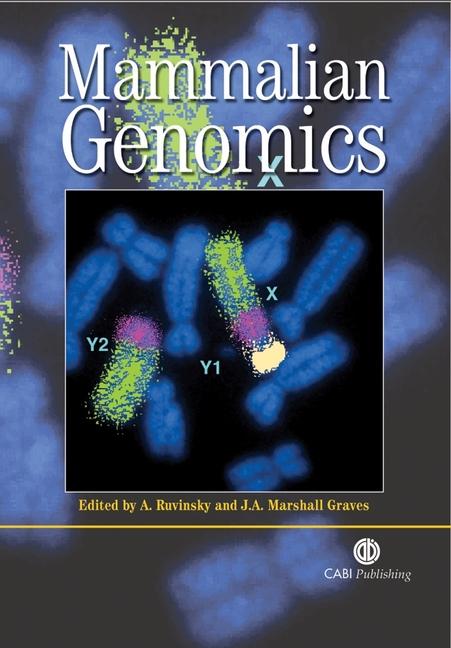
Zustellung: Do, 07.08. - Di, 12.08.
Versand in 3 Wochen
VersandkostenfreiGenomics has experienced a dramatic development during the last 15-20 years. Data from mammalian genomes such as the human, mouse and rat have already been published, while others such as the dog, cattle and chimpanzee will soon follow. This book summarizes the current knowledge of mammalian genomics and offers a comparative analysis of genomes known today. This analysis includes farm, companion and lab animals. Topics covered include structural and functional aspects of the mammalian genome, mechanisms of genomic changes at the molecular level, evolution of DNA sequences, comparative chromosome mapping and painting, genome databases, gene prediction and the use of genomic information to understand inherited diseases. Contributors include leading researchers from Europe, USA, Australia and Japan.
Inhaltsverzeichnis
Part 1. Organization of the Mammalian Genome; Linkage mapping, C Moran and J W James, University of Sydney, Australia; Mapping genomes at the chromosome level, B P Chowdhary and T Raudsepp, Texas A&M University, USA; Mapping genomes at the molecular level, F Galibert, Universite de Rennes, France, and N E Cockett, Utah State University, USA; DNA sequence of the human and other mammalian genomes, D Vaiman, INSERM, France; Part 2. Expression of the Mammalian Genome; The transcriptome, A Verger and M Crossley, University of Sydney, Australia; The proteome, M B Datto and T A Haystead, Duke University, USA; The epigenome - epigenetic regulation of gene expression in mammalian species, E Whitelaw, University of Sydney, and D Garrick, John Radcliffe Hospital, Oxford, UK; Regulation of genome activity and genetic networks in mammals, V Van Buren, and M S H Ko, National Institute of Health, USA; Including alterations in the mammalian genome for investigating the function of genes, J L Guenet, Institut Pasteur, France;Part 3. Evolution of the Mammalian Genome; Mammalian genomes in context, M I Bellgard, Murdoch University, Australia, and T Gojobori, National Institute of Genetics, Japan; Elements and mechanisms of genome change, R J O'Neill, G C Ferreri and M J O'Neil, University of Connecticut, USA; DNA sequence evolution and phylogenetic footprinting, E T Dermitzakis, The Wellcome Trust Sanger Institute, Cambridge, UK, and A Reymond, University of Geneva Medical School, Switzerland; The evolution of the mammalian karyotype, F Pardo-Manuel de Villena, University of North Carolina at Chapel Hill, USA; Comparative gene mapping and chromosome painting in mammals and the reconstruction of the ancestral mammalian karyotype, O L Serov, Russian Academy of Sciences, Russia, B P Chowdhary, J E Womack, Texas A&M University, USA, and J A Marshall Graves, The Australian National University, Australia;Part 4. Genome Analysis and Bioinformatics; Bioinformatics: from computational analysis through to integrated systems, M I Bellgard; Genetic databases, V Brusic and J L Y Koh, Institute for Infocomm Research, Singapore; Gene predictions and annotations, R Guido, Universitat Pompeu Fabra, Spain, and M Q Zhang, Cold Spring Harbor Laboratory, USA; Part 5. The Fruits of Mammalian Genomics; Genomic research and progress in understanding inherited disorders in humans and other mammals, D R Sargan, University of Cambridge, UK, and A I Agoulnik, Baylor College of Medicine, Houston, USA; Pharmacogenomics, W W Weber and J M Rae, University of Michigan School of Medicine, USA; Genome scanning for quantitative trait loci, B J Hayes, Agricultural University of Norway, Norway, B P Kinghorn, and A Ruvinsky, University of New England, Australia; Mammalian population genetics and genomics, L Chikhi, Universite Paul Sabatier, France, and M Bruford, Cardiff University, UK
Produktdetails
Erscheinungsdatum
20. Dezember 2004
Sprache
englisch
Seitenanzahl
624
Herausgegeben von
Anatoly Ruvinsky, Jennifer Marshall Graves
Verlag/Hersteller
Produktart
gebunden
Gewicht
1456 g
Größe (L/B/H)
251/181/37 mm
ISBN
9780851999104
Pressestimmen
"The scientific content of this book is of staggering proportions... As such this book is likely to prove very popular and become a highly useful resource."
Bewertungen
0 Bewertungen
Es wurden noch keine Bewertungen abgegeben. Schreiben Sie die erste Bewertung zu "Mammalian Genomics" und helfen Sie damit anderen bei der Kaufentscheidung.








